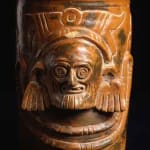Toltec Plumbate Vessel with a Sculpted Head, 1000 CE - 1200 CE
Plumbate
7.25
PF.6276
Further images
The Toltec civilization first gained ascendany in th Vallery of Mexico around 900 A.D., after the fall o Teotihuacan. Although their origins and early histor are obscure, the Toltecs appear...
The Toltec civilization first gained ascendany in th Vallery of Mexico around 900 A.D., after the fall o Teotihuacan. Although their origins and early histor are obscure, the Toltecs appear to have ancient tie to both the Mixtec and the Zapotec. The word Tolte means “master builders” in the Nahuatl language, testament to the sophistication of Tolte constructions. Their art and architecture was highl influenced by Teotihuacan as well as the ancient Olme culture. The Toltecs were technologically advanced,
capable of smelting metals. Their stonework wa impecible as the ruins of Tula demonstrate. Thi archaeological site is believed to be Tollan, th legendary capital of the Toltec civilization referre to in a number of postconquest sources. Their socia structure was headed by an elite class of warriors. Excavation have uncovered the ceremonial center tha included a pyramid structure topped by a templ dedicated to the hero-god Quetzalcoatl.
Pottery vessels of this type with their distinctiv orange hues and shiney surfaces are known a plumbate-ware. During the height of the Tolte civilization, plumate works were produced at only on place: on the Pacific slope of the Soconusco region i modern Guatemala. Furthermore, the process by which i was made seems to have been a closely guarded secret. Such wares were highly valued throughout Mesoameric and were traded along commercial networks tha extended as far as Panama. Plumate was so desirable i part because it maintains an exceptional hardness tha can be scarcely scratched with steel.
This cylindrical plumbate vessel has retained it beautiful orange hue and sculptural detail, whic inlcudes a prominent head that emerges from the side.
Featuring deeply incised circular eyes, a fring beard, and tasseled earrings, this face, although i may appear to be the head of a human, can b recognized as the visage of the mighty rain god,
Tlaloc. Tlaloc was one of the most important gods o the ancient Pre-Columbian pantheon who worshipped fro Mexico to Costa Rica. Such a vessel, honoring thi powerful deity, would have likely served a ceremonia purpose. Perhaps Toltec priests once drank from thi vessel while standing high atop a pyramid in a templ dedicated to Tlaloc.
capable of smelting metals. Their stonework wa impecible as the ruins of Tula demonstrate. Thi archaeological site is believed to be Tollan, th legendary capital of the Toltec civilization referre to in a number of postconquest sources. Their socia structure was headed by an elite class of warriors. Excavation have uncovered the ceremonial center tha included a pyramid structure topped by a templ dedicated to the hero-god Quetzalcoatl.
Pottery vessels of this type with their distinctiv orange hues and shiney surfaces are known a plumbate-ware. During the height of the Tolte civilization, plumate works were produced at only on place: on the Pacific slope of the Soconusco region i modern Guatemala. Furthermore, the process by which i was made seems to have been a closely guarded secret. Such wares were highly valued throughout Mesoameric and were traded along commercial networks tha extended as far as Panama. Plumate was so desirable i part because it maintains an exceptional hardness tha can be scarcely scratched with steel.
This cylindrical plumbate vessel has retained it beautiful orange hue and sculptural detail, whic inlcudes a prominent head that emerges from the side.
Featuring deeply incised circular eyes, a fring beard, and tasseled earrings, this face, although i may appear to be the head of a human, can b recognized as the visage of the mighty rain god,
Tlaloc. Tlaloc was one of the most important gods o the ancient Pre-Columbian pantheon who worshipped fro Mexico to Costa Rica. Such a vessel, honoring thi powerful deity, would have likely served a ceremonia purpose. Perhaps Toltec priests once drank from thi vessel while standing high atop a pyramid in a templ dedicated to Tlaloc.









